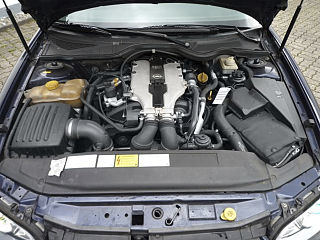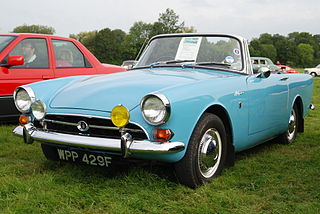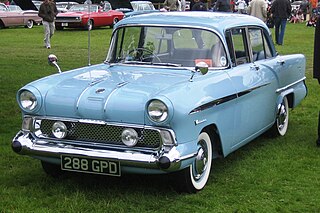
The Lotus Elise is a two-seat, rear-wheel drive, mid-engined roadster conceived in early 1994 and released in September 1996 by the British manufacturer Lotus Cars. The Elise has a fibreglass body shell atop its bonded extruded aluminium chassis that provides a rigid platform for the suspension, while keeping weight and production costs to a minimum. It is capable of speeds up to 240 km/h (150 mph). The Elise was named after Elisa Artioli, the granddaughter of Romano Artioli who was chairman of Lotus and Bugatti at the time of the car's launch.

The Saab 900 is a mid-sized automobile which was produced by Saab from 1978 until 1998 in two generations; the first from 1978 to 1993, and the second from 1994 to 1998.

The Saab 99 is a car which was produced by Saab from 1968 to 1984; their first foray into a larger class than the 96. While considered a large family car in Scandinavia, it was marketed as a niche compact executive car in most other markets. It was manufactured both in Sweden and Finland and was succeeded by the Saab 900, although the 99 continued to be produced alongside its successor. The Saab 90, an updated, less complex version using many 900 parts took over from the 99 in late 1984.

The Saab 96 is an automobile manufactured and marketed by Saab from 1960 to January 1980, replacing the 93. The 96 featured aerodynamic two-door bodywork, four-passenger seating and at first a two-stroke, three-cylinder engine, later a four-stroke V4.

The Saab Granturismo was a series of up-powered sedans sold by Saab Automobile AB from 1958 to 1968. They were powered by three-cylinder, two-stroke engines until the 1967 model year. Most variants were distinguished from the standard model by twin metal stripes along the rocker panels.

The SEAT León, also spelled Leon in some other languages, is a hatchback compact car built by the Spanish car manufacturer SEAT since October 1999.

The Citroën BX is a large family car which was produced by the French manufacturer Citroën from 1982 to 1994. In total, 2,315,739 BXs were built during its 12-year history. The hatchback was discontinued in 1993 with the arrival of the Xantia, but the estate continued for another year. The BX was designed to be lightweight, using particularly few body parts, including many made from plastics.

The Opel Calibra is a coupé, engineered and produced by the German automaker Opel between 1989 and 1997. In the United Kingdom, where it remained on sale until 1999, it was marketed under the Vauxhall brand as the Vauxhall Calibra. It was also marketed as the Chevrolet Calibra in South America by Chevrolet, and the Holden Calibra in Australia and New Zealand by Holden.

General Motors' Opel subsidiary in Europe designed a compact V6 engine with an unusual 54° vee angle. It was an iron block/aluminum head DOHC design with 4 valves per cylinder. All 54° engines were assembled at Ellesmere Port in England.

In automotive engineering a multi-valve or multivalve engine is one where each cylinder has more than two valves. A multi-valve engine has better breathing and may be able to operate at higher revolutions per minute (RPM) than a two-valve engine, delivering more power.

The Sunbeam Alpine is a two-seater sports roadster/drophead coupé that was produced by the Rootes Group from 1953 to 1955, and then 1959 to 1968. The name was then used on a two-door fastback coupé from 1969 to 1975. The original Alpine was launched in 1953 as the first vehicle from Sunbeam-Talbot to bear the Sunbeam name alone since Rootes Group bought Clément-Talbot, and later the moribund Sunbeam from its receiver in 1935.

The Sunbeam Rapier is an automobile produced by Rootes Group from 1955 until 1976, in two different body-styles, the "Series" cars and the later (1967–76) fastback shape, part of the "Arrow" range.

The Morgan 4/4 is a British motor car which was produced by the Morgan Motor Company from 1936 to 2018. It was Morgan's first car with four wheels, the name indicating that the model has four wheels and four cylinders. Early publicity and advertising material variously referred to the model as "4/4", "4-4", "Four Four", and similar names, but from the outset the factory designation was always "4/4".

The MG ZR is an MG branded "hot hatch" version of the Rover 25 supermini class car, produced by MG Rover at their Longbridge plant in Birmingham from 2001 to 2005. Compared to the Rover 25, the ZR featured a number of styling modifications and performance enhancements, such as updated sports suspension and a less baffled exhaust.

The Vauxhall Victor is a large family car produced by Vauxhall from 1957 until 1976. The Victor was introduced to replace the outgoing Wyvern model. It was renamed Vauxhall VX Series in 1976 and continued in production until 1978, by which time it had grown significantly and was viewed, at least in its home market, as a larger-than-average family car.

The Aston Martin Vantage is a series of hand-built sports cars from the British automotive manufacturer Aston Martin. Aston Martin has previously used the "Vantage" name on high-performance variants of their existing GT models, notably on the Virage-based car of the 1990s. The modern car, in contrast, is the leanest and most agile car in Aston's lineup. As such, it is intended as a more focused model to reach out to potential buyers of cars such as the Porsche 911 as well as the exotic sports and GT cars with which Aston Martins traditionally compete.

The Opel Manta is a rear-wheel-drive sports coupé built by German manufacturer Opel in two generations from 1970 to 1988. The Manta was a mildly sporting coupé based on the Ascona family car, akin to the Ford Falcon-based Mustang and its various imitators such as the Ford Capri. The Manta remained rear-wheel drive for both generations and also saw certain competition success. Its name comes from the Manta ray.

The Jaguar Mark 2 is a mid-sized luxury sports saloon built from late 1959 to 1967 by Jaguar in Coventry, England. The previous Jaguar 2.4 Litre and 3.4 Litre models made between 1955 and 1959 are identified as Mark 1 Jaguars.
Callaway Cars Inc. is an American specialty vehicle manufacturer and engineering company that designs, develops, and manufactures high-performance product packages for cars, pickup trucks, and SUVs. They specialize in Corvettes and GM vehicles. New GM vehicles are delivered to Callaway facilities where these special packages and components are installed. Then the vehicles are delivered to GM new car dealers where they are sold to retail customers, branded as Callaway. Callaway Cars is one of four core Callaway companies, including Callaway Engineering, Callaway Carbon and Callaway Competition.

The second generation of the Subaru Impreza compact car was introduced in 2000 and manufactured up to 2007 by Subaru in Ota, Gunma, Japan, in both sedan and five-door wagon bodystyles, as well as two intermediate facelifts throughout its lifespan.



















